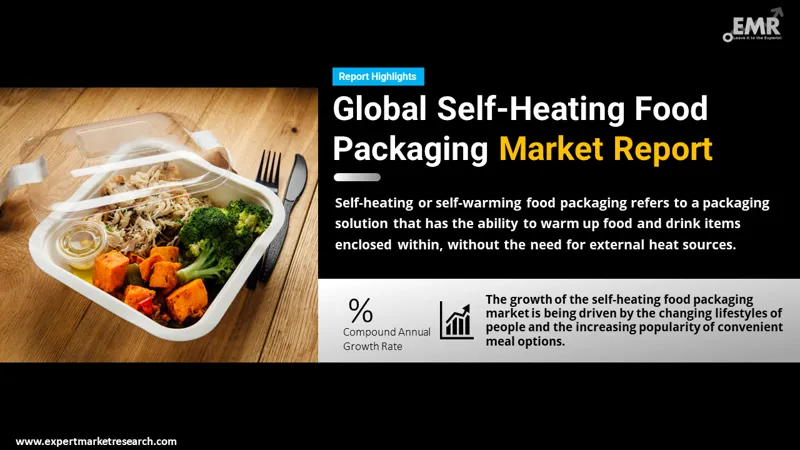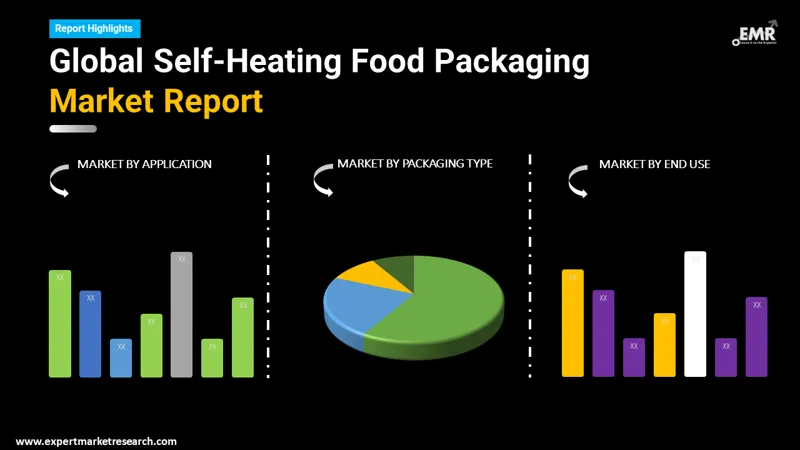
Consumer Insights
Uncover trends and behaviors shaping consumer choices today
Procurement Insights
Optimize your sourcing strategy with key market data
Industry Stats
Stay ahead with the latest trends and market analysis.
The global self-heating food packaging market size reached around USD 74.89 Billion in 2025. The market is projected to grow at a CAGR of 6.20% between 2026 and 2035 to reach nearly USD 136.67 Billion by 2035.
Base Year
Historical Period
Forecast Period
Compound Annual Growth Rate
6.2%
Value in USD Billion
2026-2035
*this image is indicative*
Self-heating or self-warming food packaging is a type of packaging that warms up food and drink items inside the container itself without the usage of additional heating sources. Typically, by use of an exothermic chemical process, the packet releases heat to preheat food. Some food items and drinks, including meat, noodles, and coffee, among others, that require heat for cooking or taste better when served hot, are prepared using these packages.

Read more about this report - REQUEST FREE SAMPLE COPY IN PDF
The EMR’s report titled “Global Self-Heating Food Packaging Market Report and Forecast 2026-2035” offers a detailed analysis of the market based on the following segments:
Breakup by Packaging Type
Breakup by Application
Breakup by End Use
Breakup by Region
According to the self-heating food packaging market report, military personnel applications are projected to dominate the market over the forecast period. Self-heating food packaging rations are used by soldiers to provide them with warm meals without the need for fire or other external heat sources which may be difficult to find on the field. The meals are heated using a heat-releasing chemical or chemicals in this flameless self-heating ration, giving military personnel greater flexibility in movement.
Meanwhile, mountaineers applications are anticipated to maintain a significant growth rate over the forecast period as mountaineers warm their meals with self-heating food packaging to prepare meals anywhere. On difficult mountain terrains, using self-heating packaging mountaineers can heat food to any temperature in a short duration of time.

Read more about this report - REQUEST FREE SAMPLE COPY IN PDF
By end use, it is projected that food will hold the largest self-heating food packaging market share. The increased demand for convenience foods along with busy lifestyles of consumers can be attributed to the growth of the segment. Self-heating food packaging is a popular option for people who are constantly on the go since it enables consumers to enjoy hot meals without the use of a stove or a microwave. Additionally, the market for self-heating food packaging in the end-use category of food has grown as a result of the growing popularity of e-commerce and online meal delivery services. Self-heating food packaging is a popular option for online meal delivery since it can preserve the food's quality and temperature while in transit.
The 42 Degrees Company, SL., established in 2017 with its headquarters in Valladolid, Spain, the company was founded with the goal of bringing cafeterias to the consumers. The 42 Degrees Company factory oversees all aspects of can manufacture, including assembly, filling, and labelling. Their products are of the highest quality due to collaborations with accredited international suppliers, internal quality control department, and outside laboratories to confirm the consistency of quality of the products.
Luxfer Magtech Inc., headquartered in Ohio in the United States and founded in 1990, specialises in creating, producing, and distributing a wide range of products that safeguard and protect from infrared countermeasure flares that shield pilots from approaching missiles. The company also provides chemical response kits that help save lives during chemical warfare attacks as well as wholesome food and beverage options for military personnel and first responders.
HeatGen, LLC., founded in 2007, is a cutting-edge self-heating company with its headquarters in Texas in the United States that is revolutionising how consumers enjoy hot beverages. With the help of HeatGenie's secure, patented technology, CPG companies can now sell single-serving, one-use cans of ready-to-drink (RTD) beverages that self-heat in two minutes. Through the company’s products, its customers can offer hot beverages to consumers on the go, including coffee, tea, soup, bone broth, and hot chocolate, among others, whenever and wherever they choose.
*Please note that this is only a partial list; the complete list of key players is available in the full report. Additionally, the list of key players can be customized to better suit your needs.*
Other market players include Tempra Technology, Scaldopack NV, Lava Gel Technologies, and Heat Technique (HotCan), among others.




*While we strive to always give you current and accurate information, the numbers depicted on the website are indicative and may differ from the actual numbers in the main report. At Expert Market Research, we aim to bring you the latest insights and trends in the market. Using our analyses and forecasts, stakeholders can understand the market dynamics, navigate challenges, and capitalize on opportunities to make data-driven strategic decisions.*
Get in touch with us for a customized solution tailored to your unique requirements and save upto 35%!
In 2025, the market reached an approximate value of USD 74.89 Billion.
The market is projected to grow at a CAGR of 6.20% between 2026 and 2035.
The market is estimated to witness healthy growth in the forecast period of 2026-2035 to reach a value of around USD 136.67 Billion by 2035.
The major drivers of the market include the rise in the standard of living among consumers, increase in the demand for healthy and nutritional on-the-go food products, and technological advancements and modernisation in packaging techniques.
Changing lifestyles of people and rising popularity of convenience meals are the key trends propelling the growth of the market.
The major regions in the market are North America, Europe, the Asia Pacific, Latin America, and the Middle East and Africa.
The membrane is punctured by a rod when the user presses on the can's bottom, allowing the water and heating chemical to mingle. The heat produced by the reaction is released, warming the content it is around. Depending on the product, a different heating agent and associated reaction may be used.
Some of the main benefits of the self-heating food are storage at any temperature, instant use, and time and energy efficiency.
The significant applications of self-heating food packaging include military personnel, mountaineers, and field engineers, among others.
The major players in the self-heating food packaging market are The 42 Degrees Company, SL., Luxfer Magtech Inc., HeatGen, LLC., Tempra Technology, Scaldopack NV, Lava Gel Technologies, and Heat Technique (HotCan), among others.
Explore our key highlights of the report and gain a concise overview of key findings, trends, and actionable insights that will empower your strategic decisions.
| REPORT FEATURES | DETAILS |
| Base Year | 2025 |
| Historical Period | 2019-2025 |
| Forecast Period | 2026-2035 |
| Scope of the Report |
Historical and Forecast Trends, Industry Drivers and Constraints, Historical and Forecast Market Analysis by Segment:
|
| Breakup by Packaging Type |
|
| Breakup by Application |
|
| Breakup by End Use |
|
| Breakup by Region |
|
| Market Dynamics |
|
| Competitive Landscape |
|
| Companies Covered |
|
Single User License
One User
USD 3,999
USD 3,599
tax inclusive*
Datasheet
One User
USD 2,499
USD 2,249
tax inclusive*
Five User License
Five User
USD 4,999
USD 4,249
tax inclusive*
Corporate License
Unlimited Users
USD 5,999
USD 5,099
tax inclusive*
*Please note that the prices mentioned below are starting prices for each bundle type. Kindly contact our team for further details.*
Flash Bundle
Small Business Bundle
Growth Bundle
Enterprise Bundle
*Please note that the prices mentioned below are starting prices for each bundle type. Kindly contact our team for further details.*
Flash Bundle
Number of Reports: 3
20%
tax inclusive*
Small Business Bundle
Number of Reports: 5
25%
tax inclusive*
Growth Bundle
Number of Reports: 8
30%
tax inclusive*
Enterprise Bundle
Number of Reports: 10
35%
tax inclusive*
How To Order

Select License Type
Choose the right license for your needs and access rights.

Click on ‘Buy Now’
Add the report to your cart with one click and proceed to register.

Select Mode of Payment
Choose a payment option for a secure checkout. You will be redirected accordingly.
Gain insights to stay ahead and seize opportunities.

Get insights & trends for a competitive edge.

Track prices with detailed trend reports.

Analyse trade data for supply chain insights.

Leverage cost reports for smart savings

Enhance supply chain with partnerships.

Connect For More Information
Our expert team of analysts will offer full support and resolve any queries regarding the report, before and after the purchase.
Our expert team of analysts will offer full support and resolve any queries regarding the report, before and after the purchase.
We employ meticulous research methods, blending advanced analytics and expert insights to deliver accurate, actionable industry intelligence, staying ahead of competitors.
Our skilled analysts offer unparalleled competitive advantage with detailed insights on current and emerging markets, ensuring your strategic edge.
We offer an in-depth yet simplified presentation of industry insights and analysis to meet your specific requirements effectively.
Share